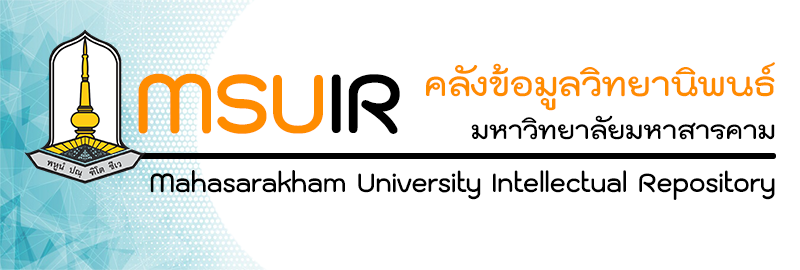Please use this identifier to cite or link to this item:
http://202.28.34.124/dspace/handle123456789/2626Full metadata record
| DC Field | Value | Language |
|---|---|---|
| dc.contributor | Athiwat Buddanang (Bhadrakavii) | en |
| dc.contributor | อธิวัฒน์ บุดดานาง (ภทฺรกวี) | th |
| dc.contributor.advisor | Pathom Hongsuwan | en |
| dc.contributor.advisor | ปฐม หงษ์สุวรรณ | th |
| dc.contributor.other | Mahasarakham University | en |
| dc.date.accessioned | 2025-05-07T10:01:01Z | - |
| dc.date.available | 2025-05-07T10:01:01Z | - |
| dc.date.created | 2024 | |
| dc.date.issued | 26/12/2024 | |
| dc.identifier.uri | http://202.28.34.124/dspace/handle123456789/2626 | - |
| dc.description.abstract | This thesis analyzes the distinctive features and interactions between Buddhism and other belief systems as reflected in the myths of the Buddha's footprint. The researcher gathered 224 accounts of these myths, both oral and written, from locations associated with Buddha's footprints in northeastern Thailand. The study applies Vladimir Propp's narrative structure method, Claude Lévi-Strauss's mythological structural approach, and the religious and belief interaction frameworks of Tambiah and Condominas. The research examines the myths of the Buddha's footprint in northeastern Thailand, highlighting their structural, tale types, and functional characteristics. These myths are marked by four key events: the meeting of characters, conflict, and acceptance, the imprinting of the footprint followed by prophecy, and the discovery, preservation, and veneration of the footprint. The analysis identifies four tale types, grouped into two pairs of opposites: truth versus falsity (original versus replica footprints) and nature versus culture (footprints in natural versus community settings). Nine motifs are also recognized, such as journey, encounter, and veneration. The research further identifies four key functions: creating narratives, establishing religious sites, developing traditions and rituals, and promoting cultural and eco-tourism areas. Additionally, five interactions between Buddhism and other belief systems are revealed, reflecting conflict, acceptance, and integration, including interactions with traditional beliefs, Nãga, Brahmanism-Hinduism, commercialized Buddhism, and revered Buddhist monks. This study underscores the cultural and historical significance of these myths as reflections of Buddhist and local belief interactions throughout the region's history. | en |
| dc.description.abstract | วิทยานิพนธ์นี้ มีความมุ่งหมายเพื่อวิเคราะห์ลักษณะเด่น และปฏิสัมพันธ์ระหว่างพระพุทธศาสนากับความเชื่ออื่น ที่สะท้อนจากตำนานพระพุทธบาทซึ่งเป็นข้อมูลมุขปาฐะ และลายลักษณ์ รวบรวมจากสถานที่ที่มีรอยพระพุทธบาทในภาคอีสานของไทย จำนวน 224 เรื่อง นำมาวิเคราะห์โดยประยุกต์ใช้วิธีการศึกษาโครงสร้างนิทานของวลาดิมี พรอพพ์ โครงสร้างตำนานปรัมปราของโคลด เลวี่-สเตราส์ และกรอบแนวคิดปฏิสัมพันธ์ทางศาสนาและความเชื่อของ ทัมไบยาห์ และคอนโดมินัส เป็นหลัก ผลการวิจัยพบว่า ลักษณะเด่นของตำนานพระพุทธบาทอีสานมี 4 ด้าน ได้แก่ ด้านโครงสร้าง ประกอบด้วยเหตุการณ์หลัก 4 เหตุการณ์ คือ เหตุการณ์เริ่มเรื่องเล่าถึงการมาพบกันของตัวละคร เหตุการณ์หลักเล่าถึงการขัดแย้งและการยอมรับ เหตุการณ์ต่อเนื่องเล่าถึงการประทับรอยแล้วพยากรณ์ และเหตุการณ์จบเรื่องเล่าถึงการค้นพบ รักษาและปฏิบัติต่อรอยพระพุทธบาท ด้านแบบเรื่อง 4 แบบ พบว่ามีลักษณะเป็นคู่ตรงข้าม 2 คู่ คู่ที่ 1 คือ แบบเรื่องรอยพระพุทธบาทที่พระพุทธเจ้าประทับ ตรงข้ามกับรอยพระพุทธบาทที่สร้างจำลอง สื่อถึงความจริงและความไม่จริง คู่ที่ 2 คือ แบบเรื่องรอยพระพุทธบาทที่อยู่ในธรรมชาติ ตรงข้ามกับรอยพระพุทธบาทที่อยู่ในชุมชน สื่อถึงธรรมชาติและวัฒนธรรม ด้านอนุภาค พบ 9 อนุภาค ได้แก่ การเดินทาง การพบ การขัดแย้ง การยอมรับ การประทับ การพยากรณ์ การค้นพบ การรักษา และการปฏิบัติต่อรอยพระพุทธบาท และด้านบทบาท พบ 4 บทบาท ได้แก่ การสร้างเรื่องเล่า การสร้างศาสนสถาน การสร้างประเพณีและพิธีกรรม และการสร้างพื้นที่การท่องเที่ยวทางวัฒนธรรมและภูมินิเวศ เป็นลักษณะเด่นนำไปสู่การค้นพบปฏิสัมพันธ์ระหว่างพระพุทธศาสนากับความเชื่ออื่น 5 ประเด็น ได้แก่ ปฏิสัมพันธ์ระหว่างพระพุทธศาสนากับความเชื่อดั้งเดิม ความเชื่อเรื่องนาค ศาสนาพราหมณ์ฮินดู ความเชื่อพุทธพาณิชย์ สะท้อนปฏิสัมพันธ์ในลักษณะการขัดแย้ง ยอมรับและผสมผสาน ส่วนความเชื่อพระเกจิอาจารย์ สะท้อนปฏิสัมพันธ์ในลักษณะการยอมรับและผสมผสาน การวิจัยนี้ชี้ให้เห็นถึงคุณค่าของตำนานพระพุทธบาทอีสาน ที่บันทึกร่องรอยปฏิสัมพันธ์พระพุทธศาสนาและความเชื่ออื่นในสังคมอีสานตั้งแต่อดีตจนถึงปัจจุบัน | th |
| dc.language.iso | th | |
| dc.publisher | Mahasarakham University | |
| dc.rights | Mahasarakham University | |
| dc.subject | ตำนานพระพุทธบาทอีสาน | th |
| dc.subject | ลักษณะเด่น | th |
| dc.subject | ปฏิสัมพันธ์ | th |
| dc.subject | พระพุทธศาสนา | th |
| dc.subject | ความเชื่ออื่น | th |
| dc.subject | Myth of the Buddha's footprint in Isan | en |
| dc.subject | Characteristics | en |
| dc.subject | Interaction | en |
| dc.subject | Buddhism | en |
| dc.subject | Other beliefs | en |
| dc.subject.classification | Arts and Humanities | en |
| dc.subject.classification | Education | en |
| dc.subject.classification | Religion | en |
| dc.title | Myth of the Buddha’s Footprints in Isan: Characteristics and Interaction Between Buddhism and Other Beliefs | en |
| dc.title | ตำนานพระพุทธบาทอีสาน: ลักษณะเด่นและปฏิสัมพันธ์ระหว่างพระพุทธศาสนากับความเชื่ออื่น | th |
| dc.type | Thesis | en |
| dc.type | วิทยานิพนธ์ | th |
| dc.contributor.coadvisor | Pathom Hongsuwan | en |
| dc.contributor.coadvisor | ปฐม หงษ์สุวรรณ | th |
| dc.contributor.emailadvisor | sumalee.c@msu.ac.th | |
| dc.contributor.emailcoadvisor | sumalee.c@msu.ac.th | |
| dc.description.degreename | Doctor of Philosophy (Ph.D.) | en |
| dc.description.degreename | ปรัชญาดุษฎีบัณฑิต (ปร.ด.) | th |
| dc.description.degreelevel | Doctoral Degree | en |
| dc.description.degreelevel | ปริญญาเอก | th |
| dc.description.degreediscipline | Department of Thai Language and Oriental Languages | en |
| dc.description.degreediscipline | ภาควิชาภาษาไทยและภาษาตะวันออก | th |
| Appears in Collections: | The Faculty of Humanities and Social Sciences | |
Files in This Item:
| File | Description | Size | Format | |
|---|---|---|---|---|
| 63010161007.pdf | 11.97 MB | Adobe PDF | View/Open |
Items in DSpace are protected by copyright, with all rights reserved, unless otherwise indicated.

